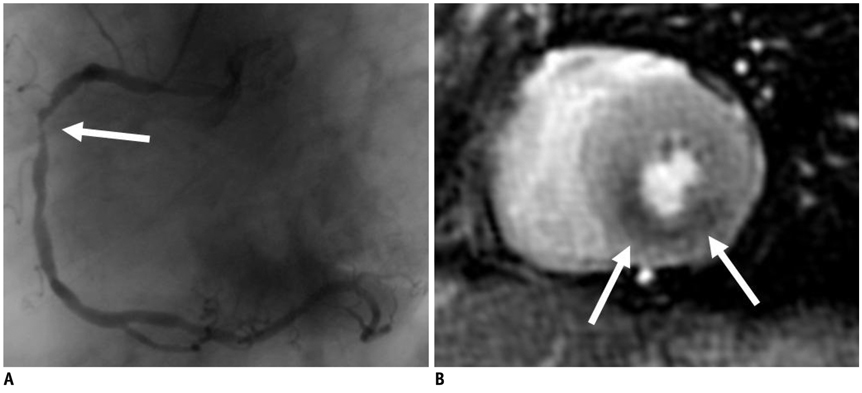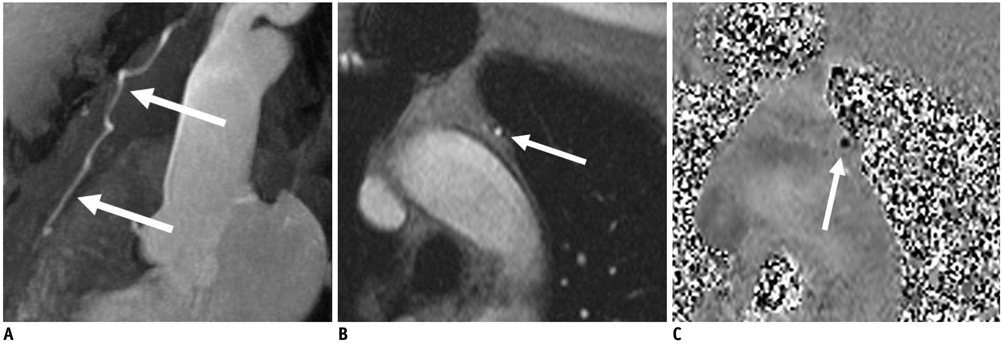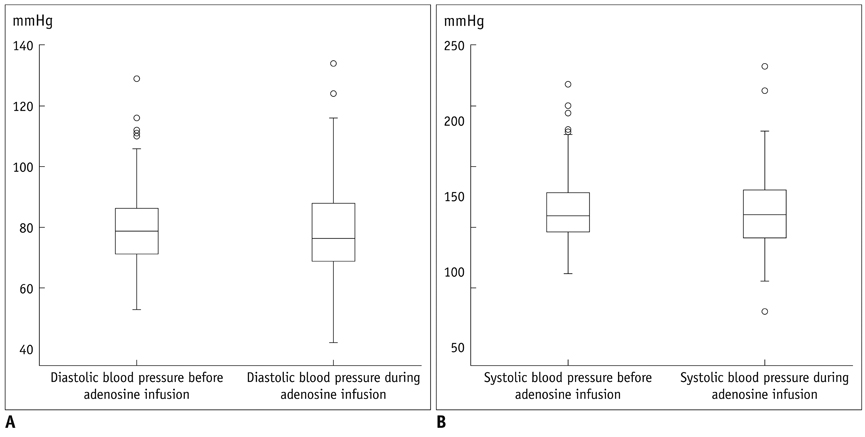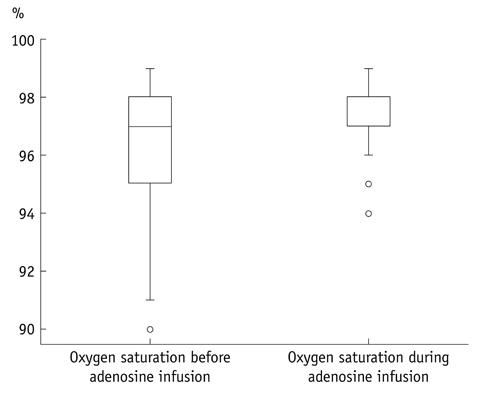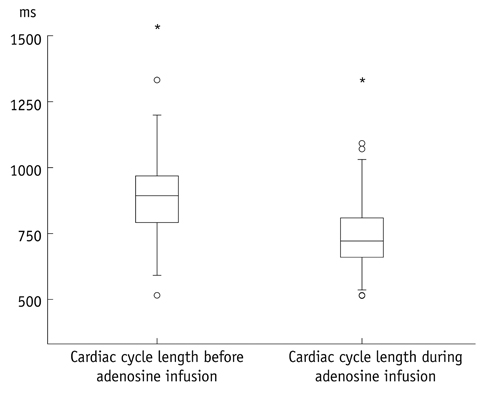Korean J Radiol.
2011 Aug;12(4):424-430. 10.3348/kjr.2011.12.4.424.
The Adverse Events and Hemodynamic Effects of Adenosine-Based Cardiac MRI
- Affiliations
-
- 1Cardiovascular Center Bethanien (CCB), Frankfurt/Main, Germany. t.voigtlaender@ccb.de
- 2Institute of Clinical Pharmacology, Technical University of Dresden, Dresden, Germany.
- 3Institute of Biostatistics, University of Mainz, Mainz, Germany.
- 4Department of Radiology, University of Heidelberg, Heidelberg, Germany.
- KMID: 1783208
- DOI: http://doi.org/10.3348/kjr.2011.12.4.424
Abstract
OBJECTIVE
We wanted to prospectively assess the adverse events and hemodynamic effects associated with an intravenous adenosine infusion in patients with suspected or known coronary artery disease and who were undergoing cardiac MRI.
MATERIALS AND METHODS
One hundred and sixty-eight patients (64 +/- 9 years) received adenosine (140 microg/kg/min) during cardiac MRI. Before and during the administration, the heart rate, systemic blood pressure, and oxygen saturation were monitored using a MRI-compatible system. We documented any signs and symptoms of potential adverse events.
RESULTS
In total, 47 out of 168 patients (28%) experienced adverse effects, which were mostly mild or moderate. In 13 patients (8%), the adenosine infusion was discontinued due to intolerable dyspnea or chest pain. No high grade atrioventricular block, bronchospasm or other life-threatening adverse events occurred. The hemodynamic measurements showed a significant increase in the heart rate during adenosine infusion (69.3 +/- 11.7 versus 82.4 +/- 13.0 beats/min, respectively; p < 0.001). A significant but clinically irrelevant increase in oxygen saturation occurred during adenosine infusion (96 +/- 1.9% versus 97 +/- 1.3%, respectively; p < 0.001). The blood pressure did not significantly change during adenosine infusion (systolic: 142.8 +/- 24.0 versus 140.9 +/- 25.7 mmHg; diastolic: 80.2 +/- 12.5 mmHg versus 78.9 +/- 15.6, respectively).
CONCLUSION
This study confirms the safety of adenosine infusion during cardiac MRI. A considerable proportion of all patients will experience minor adverse effects and some patients will not tolerate adenosine infusion. However, all adverse events can be successfully managed by a radiologist. The increased heart rate during adenosine infusion highlights the need to individually adjust the settings according to the patient, e.g., the number of slices of myocardial perfusion imaging.
Keyword
MeSH Terms
-
Adenosine/administration & dosage/*adverse effects
Adult
Aged
Aged, 80 and over
Blood Pressure/drug effects
Contrast Media/diagnostic use
Coronary Disease/*diagnosis
Female
Gadolinium DTPA/diagnostic use
Heart Rate/drug effects
Hemodynamics
Humans
Infusions, Intravenous
*Magnetic Resonance Imaging
Male
Middle Aged
Oxygen/blood
Prospective Studies
Vasodilator Agents/administration & dosage/*adverse effects
Figure
Cited by 1 articles
-
Time Efficiency and Diagnostic Accuracy of New Automated Myocardial Perfusion Analysis Software in 320-Row CT Cardiac Imaging
Matthias Rief, Fabian Stenzel, Anisha Kranz, Peter Schlattmann, Marc Dewey
Korean J Radiol. 2013;14(1):21-29. doi: 10.3348/kjr.2013.14.1.21.
Reference
-
1. Budoff MJ, Cohen MC, Garcia MJ, Hodgson JM, Hundley WG, Lima JA, et al. ACCF/AHA clinical competence statement on cardiac imaging with computed tomography and magnetic resonance. Circulation. 2005. 112:598–617.2. Constantine G, Shan K, Flamm SD, Sivananthan MU. Role of MRI in clinical cardiology. Lancet. 2004. 363:2162–2171.3. Gould KL. Noninvasive assessment of coronary stenoses by myocardial perfusion imaging during pharmacologic coronary vasodilatation. I. Physiologic basis and experimental validation. Am J Cardiol. 1978. 41:267–278.4. Gould KL, Westcott RJ, Albro PC, Hamilton GW. Noninvasive assessment of coronary stenoses by myocardial imaging during pharmacologic coronary vasodilatation. II. Clinical methodology and feasibility. Am J Cardiol. 1978. 41:279–287.5. Rossen JD, Quillen JE, Lopez AG, Stenberg RG, Talman CL, Winniford MD. Comparison of coronary vasodilation with intravenous dipyridamole and adenosine. J Am Coll Cardiol. 1991. 18:485–491.6. Belardinelli L, Linden J, Berne RM. The cardiac effects of adenosine. Prog Cardiovasc Dis. 1989. 32:73–97.7. Schreiber WG, Schmitt M, Kalden P, Horstick G, Gumbrich T, Petersen S, et al. Perfusion MR imaging of the heart with TrueFISP. Rofo. 2001. 173:205–210.8. Spies C, Mohrs OK, Madison JR, Fach A, Nowak B, Voigtlander T. Limited flow reserve in non-obstructed bypass grafts supplying infarcted myocardium: implications for cardiovascular magnetic resonance imaging protocols. J Cardiovasc Magn Reson. 2006. 8:373–379.9. Wilke NM, Jerosch-Herold M, Zenovich A, Stillman AE. Magnetic resonance first-pass myocardial perfusion imaging: clinical validation and future applications. J Magn Reson Imaging. 1999. 10:676–685.10. Schwitter J, Nanz D, Kneifel S, Bertschinger K, Buchi M, Knusel PR, et al. Assessment of myocardial perfusion in coronary artery disease by magnetic resonance: a comparison with positron emission tomography and coronary angiography. Circulation. 2001. 103:2230–2235.11. Langerak SE, Vliegen HW, de Roos A, Zwinderman AH, Jukema JW, Kunz P, et al. Detection of vein graft disease using high-resolution magnetic resonance angiography. Circulation. 2002. 105:328–333.12. Voigtlander T, Kreitner KF, Wittlinger T, Petersen S, Horstick G, Kalden P, et al. MR angiography and flow measurement in coronary arteries and coronary bypass grafts. Z Kardiol. 2001. 90:929–938.13. Ali Raza J, Reeves WC, Movahed A. Pharmacological stress agents for evaluation of ischemic heart disease. Int J Cardiol. 2001. 81:157–167.14. Biaggioni I, Killian TJ, Mosqueda-Garcia R, Robertson RM, Robertson D. Adenosine increases sympathetic nerve traffic in humans. Circulation. 1991. 83:1668–1675.15. Karamitsos TD, Arnold JR, Pegg TJ, Cheng AS, van Gaal WJ, Francis JM, et al. Tolerance and safety of adenosine stress perfusion cardiovascular magnetic resonance imaging in patients with severe coronary artery disease. Int J Cardiovasc Imaging. 2009. 25:277–283.16. Cerqueira MD, Verani MS, Schwaiger M, Heo J, Iskandrian AS. Safety profile of adenosine stress perfusion imaging: results from the Adenoscan Multicenter Trial Registry. J Am Coll Cardiol. 1994. 23:384–389.17. Bernhardt P, Steffens M, Kleinertz K, Morell R, Budde R, Leischik R, et al. Safety of adenosine stress magnetic resonance imaging using a mobile cardiac magnetic resonance system. J Cardiovasc Magn Reson. 2006. 8:475–478.18. Greenwood JP, Younger JF, Ridgway JP, Sivananthan MU, Ball SG, Plein S. Safety and diagnostic accuracy of stress cardiac magnetic resonance imaging vs exercise tolerance testing early after acute ST elevation myocardial infarction. Heart. 2007. 93:1363–1368.
- Full Text Links
- Actions
-
Cited
- CITED
-
- Close
- Share
- Similar articles
-
- Apexcardiogram in Healthy Subjects: With Particular Reference to Intervals of Hemodynamic Events in the Cardiac Cycles
- Development of Coronary Vasospasm during Adenosine-Stress Myocardial Perfusion CT Imaging
- Effects of Adenosine Triphosphate Triphosphate on Hemodynamics and Intrapulmonary Shunting in Ethrane - N2O Anesthetized Man
- Safety Profile of Adenosine Myocardial Perfusion Imaging
- Hemodynamic and Intrapulmonary Shunt Effects of Dobutamine / Adenosine Triphosphate and Dobutamine / Sodium Nitroprusside Infusion

